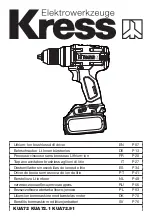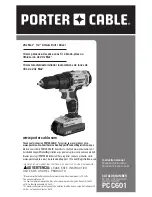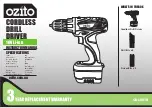
8
EN
accidents are caused by poorly maintained power
tools.
f) Keep cutting tools sharp and clean.
Properly maintained cutting tools with sharp
cutting edges are less likely to bind and are easier
to control.
g) Use the power tool, accessories and
tool bits etc. in accordance with these
instructions, taking into account the
working conditions and the work to be
performed.
Use of the power tool for operations
different from those intended could result in a
hazardous situation.
h) Keep handles and grasping surfaces
dry, clean and free from oil and grease.
Slippery handles and grasping surfaces do not
allow for safe handling and control of the tool in
unexpected situations.
5) Battery tool use and care
a) Recharge only with the charger specified
by the manufacturer.
A charger that is suitable
for one type of battery pack may create a risk of
fire when used with another battery pack.
b) Use power tools only with specifically
designated battery packs.
U
se of any other
battery packs may create a risk of injury and fire.
c) When battery pack is not in use, keep it
away from other metal objects, like paper
clips, coins, keys, nails, screws or other
small metal objects, that can make a
connection from one terminal to another.
Shorting the battery terminals together may cause
burns or a fire.
d) Under abusive conditions, liquid may be
ejected from the battery; avoid contact.
If contact accidentally occurs, flush with
water. If liquid contacts eyes, additionally
seek medical help.
Liquid ejected from the
battery may cause irritation or burns.
e) Do not use a battery pack or tool that is
damaged or modified.
Damaged or modified
batteries may exhibit unpredictable behaviour
resulting in fire, explosion or risk of injury.
f) Do not expose a battery pack or tool to fire
or excessive temperature.
Exposure to fire or
temperature above 130 °C may cause explosion.
g) Follow all charging instructions and
do not charge the battery pack or tool
outside the temperature range specified
in the instructions.
Charging improperly or
at temperatures outside the specified range may
damage the battery and increase the risk of fire.
6) Service
a) Have your power tool serviced by a
qualified repair person using only identical
replacement parts.
This will ensure that the
safety of the power tool is maintained.
b) Never service damaged battery packs.
Service of battery packs should only be performed
by the manufacturer or authorized service
providers.
DRILL SAFETY
WARNINGS
1) Safety instructions for all operations
a) Hold the power tool by insulated gripping
surfaces, when performing an operation
where the cutting accessory or fasteners
may contact hidden wiring or its own cord.
Cutting accessory or fasteners contacting a "live"
wire may make exposed metal parts of the power
tool "live" and could give the operator an electric
shock.
2) Safety instructions when using long drill
bits
a) Never operate at higher speed than the
maximum speed rating of the drill bit. At
higher speeds, the bit is likely to bend if
allowed to rotate freely without contacting
the workpiece, resulting in personal injury.
b) Always start drilling at low speed and with
the bit tip in contact with the workpiece.
At higher speeds, the bit is likely to
bend if allowed to rotate freely without
contacting the workpiece, resulting in
personal injury.
c) Apply pressure only in direct line with the
bit and do not apply excessive pressure.
Bits can bend causing breakage or loss of
control, resulting in personal injury.
SAFETY WARNINGS FOR
BATTERY PACK
a) Do not dismantle, open or shred cells or
battery pack.
b) Do not short-circuit a battery pack. Do
not store battery packs haphazardly in
a box or drawer where they may short-
circuit each other or be short-circuited by
conductive materials.
When battery pack is
not in use, keep it away from other metal objects,
like paper clips, coins, keys, nails, screws or other
small metal objects, that can make a connection
from one terminal to another. Shorting the battery
terminals together may cause burns or a fire.
c) Do not expose battery pack to heat or fire.
Avoid storage in direct sunlight.
d) Do not subject battery pack to mechanical
shock.
e) In the event of battery leaking, do not
allow the liquid to come into contact
with the skin or eyes. If contact has
been made, wash the affected area with
copious amounts of water and seek
medical advice.
f) Seek medical advice immediately if a cell
or battery pack has been swallowed.
g) Keep battery pack clean and dry.
h) Wipe the battery pack terminals with a
clean dry cloth if they become dirty.
i) Battery pack needs to be charged before
use. Always refer to this instruction and
use the correct charging procedure.
j) Do not maintain battery pack on charge
when not in use.
Содержание KUA72
Страница 2: ......
Страница 3: ...12 1 2 3 4 5 7 6 11 10 9 8 ...
Страница 4: ...2 1 1 1 2 100 0 2 1 B2 B1 A2 A1 A3 A4 ...
Страница 5: ...C2 C3 C4 D2 D1 C1 ...
Страница 6: ...D3 E 1 2 G F 14 1 2 4 6 8 10 16 18 14 1 2 6 8 10 16 18 ...
Страница 82: ......
Страница 83: ......
Страница 84: ...Copyright 2020 Positec All Rights Reserved AR01523300 ...









































